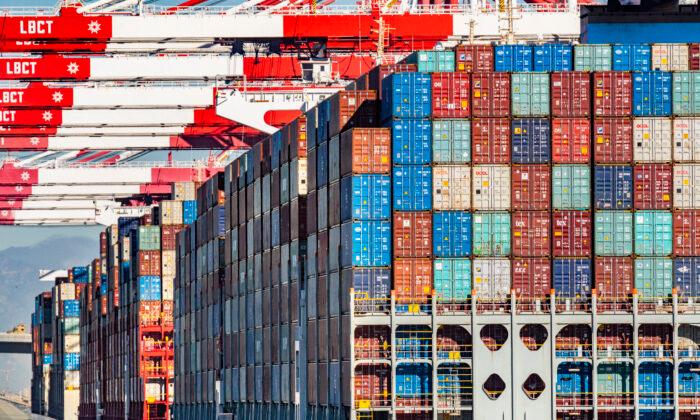Omicron outbreaks have exacerbated shipping congestion across the globe, with major Chinese and U.S. ports affected. Experts forecast that supply chain bottlenecks will continue into at least the second half of this year.
With a fresh wave of COVID-19 outbreaks spreading in China, Chinese Communist Party (CCP) officials have launched mass lockdowns and testing, driven by the central government’s “zero-COVID” policy. Consequentially, major manufacturers have closed their plants, triggering labor shortages and blockages at ports. Economists warn the potential impact of the current pandemic could be alarming as more challenging bottlenecks are likely to surface in the future.
Bloomberg reported on Jan. 13 that after the COVID-19 outbreak in Chinese port city
Ningbo, shipping firms ordered their cargo vessels to turn to Shanghai to avoid delays, causing overcrowding in the world’s largest container port. Meanwhile, Ningbo, the world’s third largest container port, suspended part of its freight services while some ships diverted south from Ningbo to another port city Xiamen.
Freight forwarders said the influx of ships into Shanghai had led to about a one-week postponement in container ships there, which could in turn affect American and European ports that are already backlogged.
In the United States, the world’s largest consumer market, California’s Los Angeles and Long Beach are the two busiest ports through which approximately
40 percent of the nation’s shipping containers enter the country. The number of vessels anchored off the two ports has become
a barometer measuring global supply chain turbulence.
According to
Marine Traffic, an online ship tracking website, there were 198 container ships berthed outside the two ports on Jan. 13 local time, with another 162 about to dock.
In October 2021, Robert Garcia, Mayor of Long Beach, already said the United States was facing an unprecedented backlog in shipping at Long Beach and Los Angeles due to the global COVID-19 pandemic, with major production changes exacerbating decades-long supply chain challenges. At that time, over 50 container ships were counted waiting to unload outside the two ports, which was a record high.
Inflation Pressures
Shipping makes up the movement of at least 90 percent of global goods. The cost of transportation by sea has soared over the past year due to port congestion.For the week ending Jan. 20, the World Container Index reported a 1.6 percent increase in shipping costs to $9,698.33 per 40 ft container, which is up 82 percent year-over-year, according to shipping consulting services provider
Drewry. Moreover, freight rates from Shanghai to Los Angeles rose 5 percent or $576 to reach $11,197, and rates from Shanghai to New York surged 2 percent or $216 to reach $13,987 per 40 ft container.
The U.S.
Consumer Price Index rose 7 percent year-over-year in December 2021, according to the latest data from the U.S. Department of Labor—the fastest growth since June 1982. Strong consumer demand has intensified supply shortages.
Also in 2021,
U.S. wholesale inflation soared at a record pace. Last November, the Producer Price Index rose 9.8 percent year-over-year, the largest hike since the government began compiling this data in 2010.
“The shipping industry and experts generally believe that supply chain bottlenecks are very unlikely to ease this year,” Prof. Frank Tian Xie from the University of South Carolina, Aiken, told The Epoch Times on Jan. 13. “The crises may even continue into next year. So I’m afraid the issue of U.S. inflation will not be solved very soon.”
He said that the port congestion has triggered logistics stagnation, causing soaring prices in global energy and food, adding to inflation pressures.
“The epidemic led to tough restrictions in many countries, including the United States,” Xie said. “As a result, a large number of dock workers and truckers were prevented from going out to work. However, as countries begin their economic recover, the public’s purchasing power is strongly bouncing back; and demand for products from China and other Asian nations will rise significantly.”
US Likely to Diversify Supply Chains
Dr. Hua Chia-cheng, an economist at the Taiwan Institute of Economic Research, told The Epoch Times on Jan. 13 that the key to easing the ongoing supply chain disruption hinges on whether the global pandemic stably subdues. He forecast that the chaos could continue until at least the second half of the year.He also mentioned another long-term impact of the pandemic in that the majority of countries, including the United States, are now considering their over-reliance on China’s supply chains.
“To avoid the risk of recurrence of similar crises,” Hua said, “the world will diversify their industries to guarantee reliable supply chains.”
In the medium to long term, he said, the U.S. government might consider modifying its supply chains to domestically produce essential products, including items like masks and pharmaceuticals.
Joyce Liang contributed to this report.






